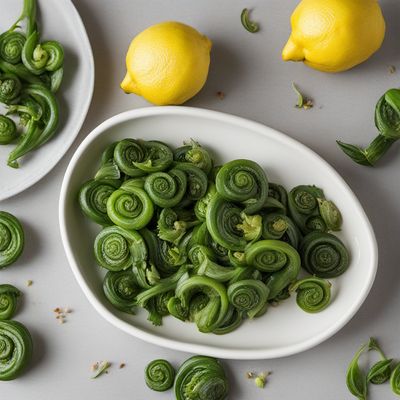
Ingredient
Vegetable fern
The Edible Green Delight
Vegetable fern, or fiddleheads, are the young, tightly coiled shoots of fern plants. They are harvested in the spring when they are still curled up and have a vibrant green color. Fiddleheads have a crisp texture and a flavor profile that is often described as a combination of asparagus and artichokes. They are commonly used in various dishes, including salads, stir-fries, and soups.
Origins and history
The consumption of fiddleheads dates back centuries and is deeply rooted in various cultures around the world. They have been a traditional food source for Indigenous peoples in North America and have also been enjoyed in Asian cuisines, particularly in Japan and Korea. Fiddleheads are known for their unique appearance and taste, making them a highly sought-after ingredient during the spring season.
Nutritional information
Fiddleheads are a good source of vitamins A and C, as well as dietary fiber. They are also low in calories and fat. However, it is important to note that fiddleheads should be cooked before consumption to remove any potential toxins. Raw or undercooked fiddleheads may contain a naturally occurring toxin called ptaquiloside, which can cause digestive issues.
Allergens
There are no known allergens associated with fiddleheads.
How to select
When selecting fiddleheads, look for tightly coiled shoots with a vibrant green color. Avoid fiddleheads that are wilted, discolored, or have opened up, as they may be past their prime. It is best to purchase fiddleheads from reputable sources that specialize in fresh produce. If foraging for fiddleheads, make sure to properly identify the fern species and harvest them from clean, unpolluted areas.
Storage recommendations
To maintain the freshness and quality of fiddleheads, it is best to consume them as soon as possible after harvest or purchase. If storing them, place them in a perforated plastic bag in the refrigerator to maintain their crispness. Fiddleheads should be consumed within a few days to ensure optimal flavor and texture.
How to produce
Fiddleheads can be grown by amateur gardeners or foraged from the wild. To grow fiddleheads, plant fern spores or purchase young fern plants from a nursery. Provide them with a moist and shaded environment, as ferns thrive in these conditions. Foraging for fiddleheads requires knowledge of fern species and proper harvesting techniques to ensure sustainability and safety.
Preparation tips
Fiddleheads can be prepared in various ways to highlight their delicate flavor and texture. They can be blanched and then sautéed with garlic and olive oil for a simple yet flavorful side dish. Fiddleheads can also be added to salads, stir-fries, or soups to provide a unique twist. It is important to cook fiddleheads thoroughly to remove any potential toxins and ensure their safety for consumption.
Culinary uses
Fiddleheads are commonly used in salads, stir-fries, soups, and side dishes. They can be added to pasta dishes, omelets, or quiches for an earthy and vibrant touch. Fiddleheads are also a popular ingredient in traditional Indigenous cuisines and Asian dishes, particularly in Japan and Korea.
Availability
Fiddleheads are commonly available in North America, particularly in regions with a temperate climate. They are also cultivated and enjoyed in Asian countries like Japan and Korea.
More ingredients from this category
Recipes using Vegetable fern

Boiled Fiddleheads with Ginger and Soy Sauce
Ginger-infused Fiddleheads: A Delightful Liaoning Delicacy

Maine Fiddleheads with Lemon Butter Sauce
Delightful Fiddleheads: A Zesty Twist on a Maine Classic

Batak-style Sayur Pakis (Fern Soup)
Savory Batak Fern Soup: A Delightful Twist on a Traditional Dish

Sikkimese-inspired Olla Podrida
Himalayan Fusion Delight: Sikkimese-inspired Olla Podrida

